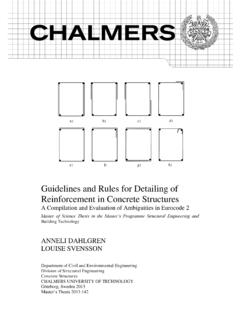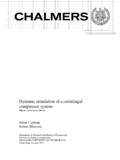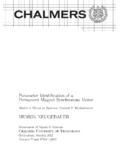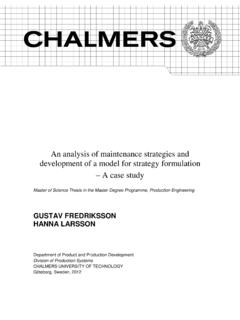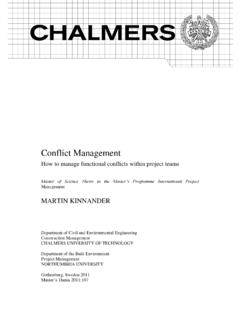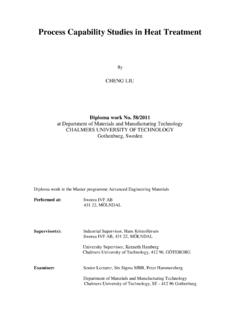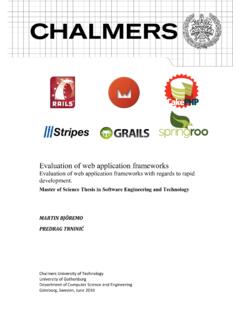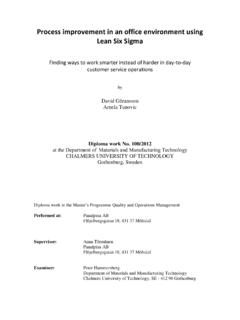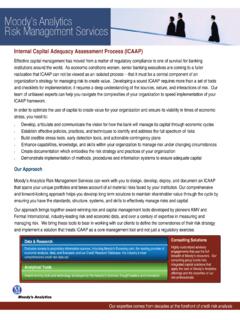Transcription of Design of a 2.5kW DC/DC Fullbridge Converter
1 Design of a DC/DC Fullbridge Converter Master of Science Thesis Christian Andersson Department of Energy and Environment Division of Electric Power Engineering CHALMERS UNIVERSITY OF TECHNOLOGY G teborg, Sweden, 2011 Abstract In this thesis, an isolated Fullbridge DC/DC Converter has been designed and analyzed regarding its efficiency and weight. By increasing the switching frequency, the magnetic components in the Converter can be made smaller, in this thesis a switching frequency of 20 kHz has been compared with a switching frequency of 100 kHz. The transformer in the Converter can be winded in different ways which will affect the rectification on the low voltage side, this thesis has analyzed the center-tap- and fullwave- bridge -rectification.
2 Efficiency improvement-techniques such as zero voltage switching, ZVS, and synchronous rectification have also been analyzed. It was found that by going from 20 kHz to 100 kHz the Converter weight can be reduced by approximate 10% and by using the center-tap- instead of fullwave- bridge rectification the efficiency can improve by approximately 1-3%, from around 94% up to approximately 97% efficiency. Acknowledgements I would like to thank my supervisor at Chalmers, Torbj rn Thiringer, for his patience, help and support during this project. I would also like to thank the people at the Electric Power Engineering division at Chalmers for their technical support.
3 Finally, I would like to thank co-working student Mehdi Erfani for useful discussions during this project. Contents 1. Introduction .. 1 Background .. 1 Purpose .. 1 Delimitations .. 1 2. Theory .. 2 DC/DC Converter .. 2 Choice of DC/DC Converter topology .. 2 Diode fundamentals .. 6 MOSFET fundamentals .. 7 IGBT fundamentals .. 9 Transistor losses .. 11 Transformer Design .. 14 Magnetic behavior .. 14 Core Materials .. 15 Transformer setup .. 17 Transformer losses .. 20 LC-filter .. 22 Needed inductance value .. 22 Inductor Setup .. 24 Converter Efficiency Strategies .. 26 Zero voltage switching, ZVS .. 26 Synchronous rectification.
4 27 3. Design Results .. 28 Selection of Power Semiconductor components .. 28 High voltage side .. 28 Low voltage side .. 30 Transformer setup .. 33 Transformer losses .. 36 LC-filter Design .. 40 Calculation of Inductance and Capacitance .. 40 Core Selection .. 41 Inductor losses .. 42 Total Converter losses .. 44 Converter losses 20kHz .. 44 Converter losses 100kHz .. 45 Efficiency comparison .. 46 4. 47 5. References .. 48 1 1. Introduction Background The world is not like it used to be, people nowadays are more environment-conscious and this way of new thinking have put pressure on the car industry into research and development of more sustainable energy sources.
5 This has lead to different kinds of hybrid electrical vehicles (HEVs) on the market. A technology that allows cooperation between an internal combustion engine (ICE) and an electrical engine with the main purpose to reduce the use of the ICE and thereby reduce the pollution. In HEVs there are many different voltage busses for different purposes of vehicle operation. There is therefore a need of galvanic isolated DC/DC converters in the system to link different voltage busses with each other and allow transfer of energy back and forth. For example, one of the converters convert the high voltage (300-400 V) in the main battery to low voltage (12 V) for use in electrical equipment.
6 With more components in the system it is of great importance to have efficient and reliable components in the driveline to achieve an energy flow with a power loss as low as possible along the way. Purpose The purpose of this project is to Design an isolated DC/DC Converter for HEV application, a DC/DC Converter that will link the main battery (300-400 V) with the electrical equipment (12V) in the vehicle. Main objectives are to achieve high efficiency and low weight. Moreover, a comparison between two different rectifying-techniques, center-tap and fullwave bridge , will be made. Finally a goal is to compare result obtained using two different switching frequency in the system, 20 kHz and 100 kHz.
7 Delimitations This project has been completely theoretical. The proposed setup has not been build and tested. All calculations are based on information given from the manufacturers of the different components. The control system for the Converter has not been considered as well. 2 2. Theory DC/DC Converter Choice of DC/DC Converter topology The first thing to decide when designing a power supply is to choose a suitable topology. A set of factors will drive the decision, such as: - Input and output voltage (lower, higher or inverted, multiple outputs etc) - Output power (Some topologies are limited in power) - Safety ( isolated /non- isolated Converter ) - Cost (related to number of power devices) The most common type of DC-DC converters can be divided into two categories depending on how they transfer the power.
8 The energy can go from the input through the magnetics to the load simultaneously or the energy can be stored in the magnetics to be released later to the load. Table lists the most common DC-DC converters and their typical power limitation [1]. Table - Overview of DC/DC -converters and their typical power limitation Energy flow Energy storage Non isolated buck (<1 kW) Boost (<150 W) buck -boost (<150 W) Cuk (<150 W) isolated Half- bridge (250 W-1 kW) full - bridge (>1 kW) Flyback (<150 W) With given inputs that are listed below in Table for this project, the choice has been the full - bridge topology. Table Input parameters for the Converter Parameter Value Battery Voltage, Vd 300 400 V Output Voltage, Vo 12 V Output max current, Io 208 A Output max power, Po 2500 W This topology will be analyzed with two types of secondary winding-techniques such as the center-tap configuration and fullwave- bridge configuration according to Figure 3 Figure - Fullbridge Converter with a center-tap- and a fullwave bridge -cnfiguration The switching topology used for the full - bridge Converter is the bipolar voltage switching, where the transistors are switched in pairs.
9 Transistors T1 and T4 are considered as one switch pair and transistors T2 and T3 are considered as the other switch pair. The output voltage V0 is controlled and regulated by the PWM scheme seen in Figure where a sawtooth signal is compared with a voltage control signal from the control circuit. 4 Figure - Fullbridge Converter switch topology During the first half period, the switchpair T1 and T4 are conducting as long as the sawtooth signal is lower than the control signal. When it exceeds the control signal the transistors stops to conduct until the second half period takes place when the switch-pair T2 and T3 starts to conduct until the sawtooth signal yet again exceeds the control signal.
10 This procedure repeats itself from period to period. Another type of control is the phase-shift control which provides a convenient method for achieving zero voltage switching, significantly reducing the switching losses. Stored energy is then used to charge and discharge bridge switch capacitance during a freewheeling stage created by phase shifting the ON times of opposite pairs of transistors in the bridge configuration. 5 The current waveform on the primary and secondary side can be seen below in Figure Figure Primary- and secondary current waveforms and by using these current waveforms, the RMS currents can be expressed as , = 12 = , , = , = 12 =12 , 1 + The resulting output voltage V0 is therefore directly related to the transistors resp.
